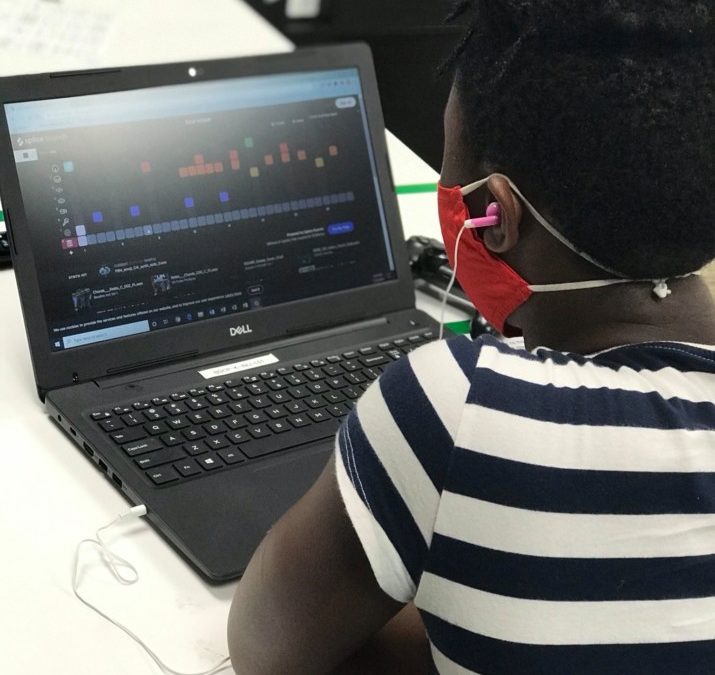Portland, OR. Oregon nonprofits are facing some big obstacles because of the COVID-19 pandemic. Nonprofits like Boy & Girls Club (seen above) are still serving kids in our area, but fundraising is tougher.
Across Oregon, the nonprofit community is pulling together in amazing ways to combat the impacts
of the COVID-19 pandemic, including responding to emergent needs by establishing new services and programs and responding to new clients. Even as creative as the nonprofit sector has become in moving programs online, investing in PPE, and physically distanced staff and volunteers, a new study indicates many of our vital institutions – domestic violence shelters, children’s museums, food banks, and homeless shelters – are at the breaking point.
The Nonprofit Association of Oregon (NAO), along with several other organizations, worked to quantify the impact and challenges of the COVID-19 crisis on 501(c)(3) nonprofits through a survey that ran from June 2 to June 28, 2020. This preliminary report is a summary of key findings from responses shared by 490 Oregon nonprofit leaders. The respondents represent a broad cross-section of charitable nonprofit types and sizes from across the state.
Key Findings:
Researched by the Nonprofit Association of Oregon (NAO), Portland State University’s Nonprofit Institute, Mercy Corps Northwest, and Oregon Voluntary Organizations Active in Disasters (ORVOAD)
Nonprofits are Essential to COVID-19 Response Efforts: 49% of the nonprofits reported adding new clients, services, or programs since the start of the pandemic. Of these nonprofits, 77% have added
new services to directly assist with COVID-19 response, demonstrating the essentiality and agility of nonprofits in responding to societal needs and emergencies. Additionally, 23% reported they are serving brand new clients from their pre-COVID programming.
Pandemic significant Impacts on Core Programming:
Nonprofits indicated that their current levels of operations or services have been significantly impacted by the pandemic. 60% of respondents reported functioning at reduced levels of services, while 14% reported seeing no change, and 18% reported an increase in their levels of services or operations.
Changes in Demand for Nonprofits’ Services: 38% of respondents have seen an increase in demand for their services, as a result of the COVID-19 crisis. 31% have seen a decrease, with 22% seeing no change.
It should be noted that some demands for services
of educational, arts and culture, and environmental nonprofits have decreased as a direct result of government-mandated shelter-in-place requirements.
“We expect to see a food insecurity crisis… that will be unlike anything we’ve seen for generations. We also expect to see a significant increase in mental health and addiction crisis…”
Impact of COVID-19 on Oregon Charitable Nonprofits Preliminary Report ‒ Key Findings Summary – July 30, 2020
Impacts on Paid Staff and Volunteers: The capacity to serve the missions of nonprofits has been severely impacted by a decrease in the total number of volunteer hours worked, due to state closures and social distancing measures. 73% of nonprofits that rely on volunteers have seen a decrease in volunteer hours. In addition, 38% of nonprofits reported a decrease in the number of hours worked
by paid employees. To cope with resource pressures, nonprofits have implemented several austerity measures, including layoffs (79 nonprofits), furloughs (75 nonprofits), reduced employee salaries/wages (45 nonprofits), and reduced leadership salaries/wages (47 nonprofits).
Impacts on Funding: Charitable nonprofits rely on earned income, government contracts and grants, and charitable contributions to offer their services. The survey showed these streams have been significantly impacted by the pandemic.
- 54% of nonprofit respondents reported losses in earned income, 35% consist of nonprofits losing more than 50% in earned income. For 28% of the nonprofits, earned income remains stable. Looking ahead through the end of 2020, nonprofits expect this picture to remain relatively similar, with slightly fewer nonprofits (23%) anticipating earned revenue decreases of 50% or more.
- Regarding donations from Individuals, 22% of nonprofits reported seeing “No Change,” with 23% seeing an “Increase” in support from individuals. Looking ahead through the end of 2020, only 13% anticipate donations to remain stable, 18% expect an increase, and 38% anticipate losing 16% or more in individual donations, with 17% unsure of what to expect.
- Also encouraging, only 12% of nonprofits reported losing more than 50% in donations from foundations or corporations; with 29% reporting no change. 28% of respondents saw an increase since the pandemic started.
- Nonprofits also reported positive results regarding government contracts and grants (excluding Paycheck Protection Program and Economic Injury Disaster Loan). 48% of nonprofits did not see any change as of June, and 22% reported an increase. Looking ahead through the end of 2020, nonprofits are less sure of government funding sources, with 18% anticipating cuts of 16% or greater. Interestingly, 40% of nonprofits remain optimistic that they will not see any changes. This was a surprise to the research team in light of announced cuts by the State of Oregon and grim budget forecasts for most counties and municipalities. Permanent Closures: Only four nonprofits reported making the tough decision to permanently close. An additional two organizations anticipate closing permanently before the year is out. Experience with the Paycheck Protection Program (PPP) and Economic Injury Disaster Loan (EIDL): Not all nonprofits are eligible for the PPP or EIDL programs. Out of 480 respondents, 31% did not apply for PPP. Only 58% that applied, reported successfully receiving requested amounts. 89% of respondents will seek full forgiveness, and 8% will seek partial forgiveness. Only 11% of nonprofits successfully applied and received their requested amounts of EIDL funding. 76% of the respondents did not apply for EIDL funding. Some organizations that did apply were still awaiting a determination at the time of the survey.
“We canceled our 2020 season of 50 concerts and school programs, furloughed our permanent staff of 4.5 and did not hire our seasonal staff of 5 tour crew.”
“We work to protect community health from pesticide exposure. Communities of color and low-income communities are already disproportionally affected by pesticides, and now the impact of COVID-19 has increased health risks. We are dedicating more energy and resources to assist front line farm worker communities as they continue to work with inadequate PPE and support.”
Equity, Inclusion, and Access: 40% of organizations reported applying an equity lens to program and operating decisions caused by COVID-19, but only some gave specifics. In an environment where
so many programs have moved online, 35% of respondents indicated serious concerns about the technology available to their clients.
Top Five Concerns for the Future: Nonprofits reported being either “Very Concerned” or “Extremely Concerned” about the following:
Ability to Maintain Program Service Levels
56% of nonprofit respondents had significant concerns in their ability to maintain program service levels.
Mental Health/Stress Reduction for Our Employees
49% of respondents had serious concerns about the mental health and stress of their employees.
Revenue to Cover Operating Expenses through 2020
46% of nonprofits indicated they are worried about covering operating expenses through year-end.
Meeting New Social Distance Operating Procedures
44% of respondents reported they are concerned and sometimes confused by changing social distancing procedures.
Keeping Our Volunteers Engaged
42% of nonprofits are feeling stress in keeping their volunteers engaged.
“We serve anyone homeless or near
homeless due to domestic or sexual violence, or sex trafficking… Our shelter has remained… open and is full…. We are using emergency funds to pay for hotels. This is not sustainable…”
Future Sustainability: 48 out of 56 nonprofits reported significant concerns over their future survival and ability to sustain their funding, fundraising, and programs. This group of nonprofits is dominated by arts, culture and humanities, and human services nonprofits. Of these nonprofits, 40% have budgets between $1K – $5K, and 22% have budgets between $1M – $5M.
Impact of COVID-19 on Oregon Charitable Nonprofits Preliminary Report ‒ Key Findings Summary – July 30, 2020
Returning to pre-COVID-19 Levels of Operations: 28% of nonprofits foresee taking between six months to one year to return to pre-COVID-19 levels of operations. However, all this is based on the COVID-19 pandemic being contained. Only 17% of nonprofits believe they can return to pre-COVID-19 levels of operations in the next one to six months.
Conclusion
The future outlook is that the needs of communities and the resources available for response will simply become incongruent. For instance, while a sizable number of nonprofits are optimistic about the stability of government contracts and grants through 2020, the extent to which this optimism is aligned with the announced cuts by the State of Oregon and the grim budget forecasts for most counties and municipalities remains to be seen.
The data reveals that nonprofits organizations need to work to improve outreach and inclusion efforts in a totally changed environment. Even well-intended response efforts are also dramatically highlighting and exacerbating the damage and harm of the serious racial and social inequities in our nation and state. Lack of access to regular health care has compounded the pandemic for minorities, immigrant communities, the homeless, and the poor. The ‘digital divide’ denies many people both in cities (due to income disparities) and in rural areas access to vital information about the pandemic and online portals for financial assistance. The debacle that is the Oregon unemployment filing system has caused even greater strains.
The sustained support of federal and state governments and foundations with direct and continuous fiscal assistance is imperative. The nonprofit sector is part of our “critical civic infrastructure” and
must be thought of in terms of not only preserving and providing our safety net but also building the quality of life we want in our communities. Unavoidable cuts in state and county budgets due to a down economy and less taxable income from individuals and companies will undercut much of the relief effort for people and communities in need. This is the time when the government and foundations need to release funds from their respective emergency reserves. Without immediate attention and firm commitments of resources to this critical sector, our efforts to recover and move forward as a state will severely be impeded.
“We are having to completely remake our school. The state mandates on stable group size and other health and safety mandates will shift our daily work and ability to provide programming.”
Researched by the Nonprofit Association of Oregon (NAO), Portland State University’s Nonprofit Institute, Mercy Corps Northwest, and Oregon Voluntary Organizations Active in Disasters (ORVOAD)

















